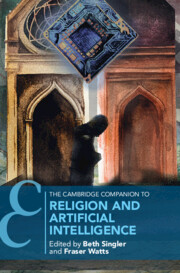Book contents
- The Cambridge Companion to Religion and Artificial Intelligence
- Cambridge Companions to Religion
- The Cambridge Companion to Religion and Artificial Intelligence
- Copyright page
- Contents
- Contributors
- Acknowledgements
- 1 Introduction
- 2 Steps towards Android Intelligence
- Part I Religions and AI
- Part II Social and Moral Issues
- Part III Religious Studies
- 13 The Anthropology and Sociology of Religion and AI
- 14 Simulating Religion
- 15 Cognitive Modelling of Spiritual Practices
- 16 Artificial Companions and Spiritual Enhancement
- Bibliography
- Index
- Cambridge Companions to Religion (continued from page ii)
- References
15 - Cognitive Modelling of Spiritual Practices
from Part III - Religious Studies
Published online by Cambridge University Press: 20 November 2024
- The Cambridge Companion to Religion and Artificial Intelligence
- Cambridge Companions to Religion
- The Cambridge Companion to Religion and Artificial Intelligence
- Copyright page
- Contents
- Contributors
- Acknowledgements
- 1 Introduction
- 2 Steps towards Android Intelligence
- Part I Religions and AI
- Part II Social and Moral Issues
- Part III Religious Studies
- 13 The Anthropology and Sociology of Religion and AI
- 14 Simulating Religion
- 15 Cognitive Modelling of Spiritual Practices
- 16 Artificial Companions and Spiritual Enhancement
- Bibliography
- Index
- Cambridge Companions to Religion (continued from page ii)
- References
Summary
One of the ways in which artificial intelligence can be a useful tool in the scientific study of religion is in developing a computational model of how the human mind is deployed in spiritual practices. It is a helpful first step to develop a precise cognitive model using a well-specified cognitive architecture. So far, the most promising architecture for this purpose is the Interacting Cognitive Subsystems of Philip Barnard, which distinguishes between two modes of central cognition: intuitive and conceptual. Cognitive modelling of practices such as mindfulness and the Jesus Prayer involves a shift in central cognition from the latter to the former, though that is achieved in slightly different ways in different spiritual practices. The strategy here is to develop modelling at a purely cognitive level before attempting full computational implementation. There are also neuropsychological models of spiritual practices which could be developed into computational models.
Keywords
- Type
- Chapter
- Information
- The Cambridge Companion to Religion and Artificial Intelligence , pp. 257 - 274Publisher: Cambridge University PressPrint publication year: 2024

